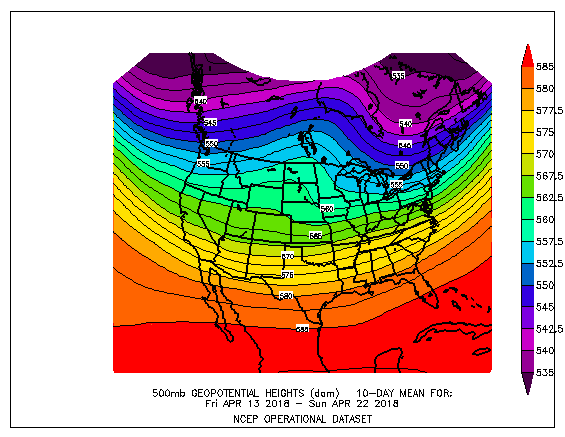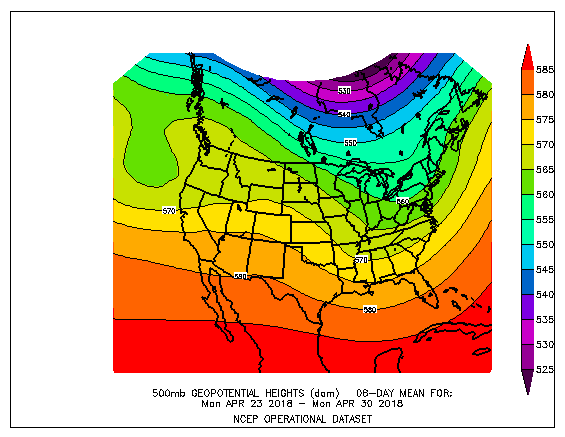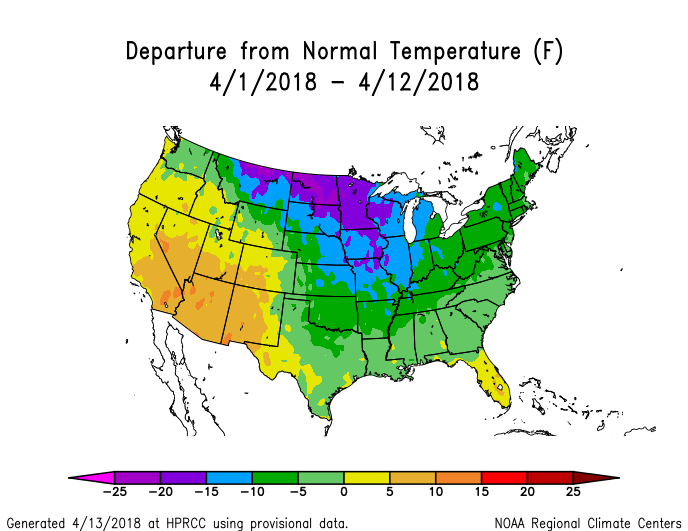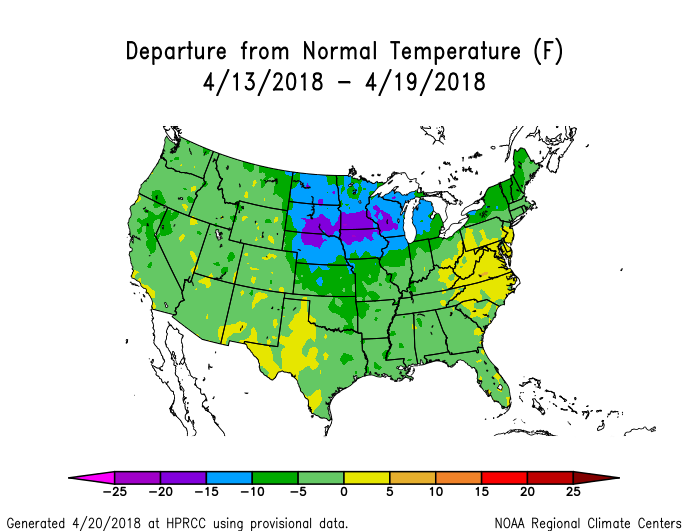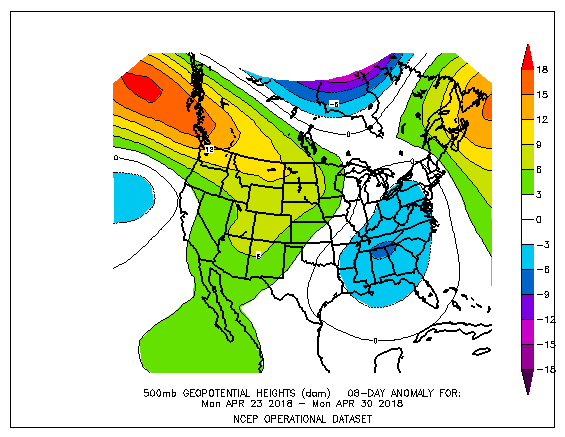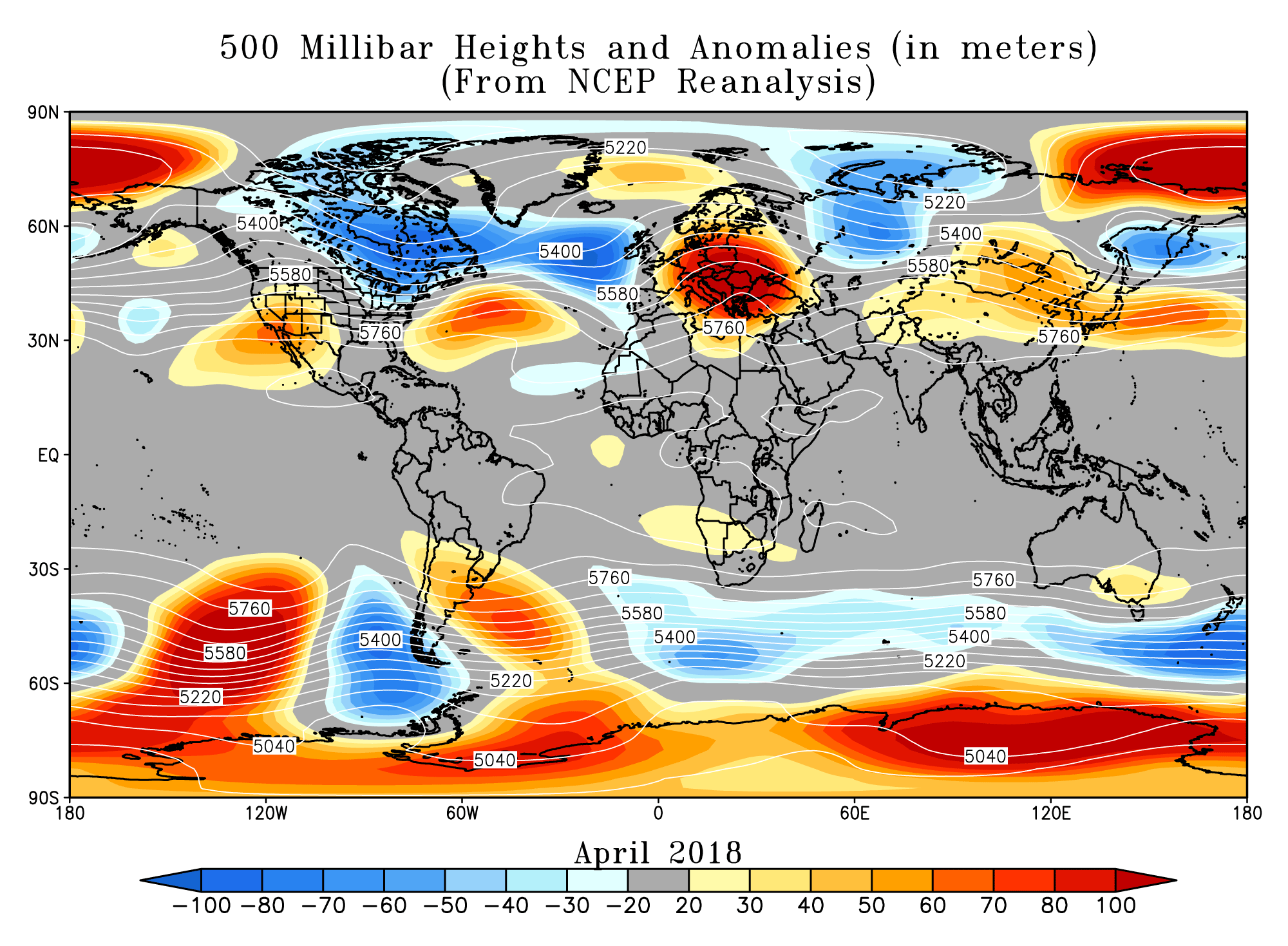Note: This Synoptic Discussion describes recent weather events and climate anomalies in relation to the phenomena that cause the weather. These phenomena include the jet stream, fronts and low pressure systems that bring precipitation, high pressure systems that bring dry weather, and the mechanisms which control these features — such as El Niño, La Niña, and other oceanic and atmospheric drivers (PNA, NAO, AO, and others). The report may contain more technical language than other components of the State of the Climate series.
Summary
The Earth's ocean-atmosphere system transitioned from a weakening La Niña state to an ENSO-neutral state during April 2018. Like the last several months, the upper-level circulation pattern was quite active this month with ridge and trough patterns migrating through the jet stream flow over the contiguous United States (CONUS). The monthly averaged circulation pattern ended up consisting of a slight long-wave ridge in the West and trough in the East, with colder-than-normal temperatures across most of the CONUS east of the Rockies, warmer-than-normal temperatures temperatures in the Southwest, wetter-than-normal bands across the Far West, northern Rockies to northern High Plains, Lower Mississippi Valley, and along the East Coast, and drier-than-normal conditions across the Southwest to interior West, most of the Great Plains, and Mid- to Upper Mississippi Valley. The persistent dryness led to worsening drought conditions, especially from the Southwest and southern Plains to Mid-Mississippi Valley, while the wet conditions contracted drought and abnormal dryness in the Southeast and Far West. Drought contraction outpaced expansion, so the national drought footprint shrank a bit when compared to the beginning of April. The active fronts and low pressure systems generated severe weather — but mostly in the Lower Mississippi and Ohio Valleys to Southeast where Gulf of Mexico moisture and clashing air masses provided the energy and dynamics — and, in combination with the cold temperatures, kept a snow cover active across the northern Plains to Great Lakes. The upper-level circulation, temperature, and precipitation anomaly patterns suggest that the atmospheric drivers originating in the equatorial Pacific (i.e., La Niña and MJO) and North Pacific (WP) may have had a controlling influence on the month's weather. See below for details.
Synoptic Discussion
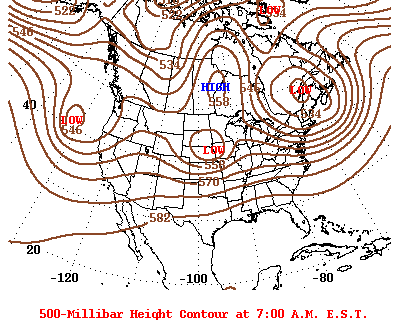 Animation of daily upper-level circulation for the month.
|
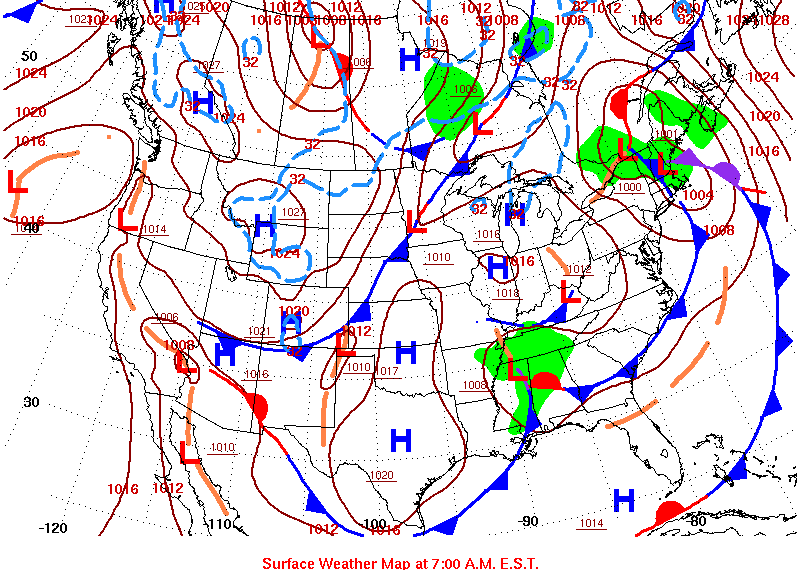 Animation of daily surface fronts and pressure systems for the month.
|
In the Northern Hemisphere, April marks the middle of climatological spring which is the time of year when solar heating increases with the rising sun angle, arctic air masses are not as cold, and a contracting circumpolar vortex forces the jet stream northward. Polar air masses influence the weather over the contiguous U.S. (CONUS) less, and the warm, dry subtropical high pressure belts influence the weather more. April 2018, however, was an aberration.
The upper-level circulation over the CONUS has been very active throughout the winter and so far this spring, with an almost never-ending parade of short-wave troughs and closed lows moving west-to-east in the jet stream flow. The air circulation around these weather systems forces warm air north toward the pole and cold polar air masses south. This back-and-forth movement of air masses helps balance out the Earth's temperature. Without it, the poles would get colder and colder and the tropics warmer and warmer; the redistribution of heat across the planet helps make Earth habitable. These patterns usually vary around the hemisphere, but sometimes they can set up camp in a region and stay awhile. This month, cold weather claimed squatters rights over much of the CONUS.
During April 2018, the parade of weather systems continued, but their pattern of motion can be grouped into three distinct periods, each characterized by specific weather phenomena, temperature anomalies, precipitation anomalies, and impacts.
During the first week (roughly April 1-8), the circulation pattern was generally westerly. Some slight ridging occurred briefly during April 9-12, but a westerly pattern generally dominated for the period April 1-12. The upper-level troughs dragged cold fronts all the way to the Gulf of Mexico, bringing below-normal temperatures to much of the country east of the Rockies. The Canadian air masses were below freezing as they crossed the northern Plains and Midwest, so surface lows along the fronts produced blankets of snow as they trekked across these regions. The air masses warmed above freezing as they plunged farther south, so precipitation in the South and along the East Coast fell mostly as rain. The troughs were laden with Pacific moisture as they hit the West Coast, with above-normal precipitation falling across northern California and Nevada to the Pacific Northwest and northern Rockies. With a more northerly storm track, the Southwest was left drier and warmer than normal during this period. The Pacific upper-level systems were generally dried out as they crossed the Rockies, leaving the Great Plains and Mid- to Upper Mississippi Valley dry. But they picked up Gulf of Mexico moisture to bring above-normal precipitation to the Lower Mississippi Valley, Ohio Valley, and parts of Florida. Some of the systems generated severe weather as they moved across the South and Midwest, with significant tornado outbreaks occurring on the 3rd and 6th.
The circumpolar vortex expanded during April 13-22 with several large upper-level closed lows taking a more southerly track across the CONUS. Pacific cold fronts were dragged across the West, while Canadian air masses reinforced the fronts once they crossed the Rockies. The resulting below-normal temperatures spread across most of the CONUS, with the greatest cold temperature departures occurring from the northern Plains to Great Lakes (7-day temperature anomalies for April 13-19 and April 16-22). Above-normal precipitation fell across parts of the West, especially the far western and northern sections, but the Pacific air masses were dried out by the coastal mountain ranges, so the Southwest continued drier than normal (7-day precipitation anomalies for April 13-19 and April 16-22). The Gulf of Mexico provided an abundant moisture source for the fronts and low pressure systems as they trekked across the central and eastern U.S., bringing above-normal precipitation to the Plains to East Coast. A dynamic storm track and below-freezing air kept the snow cover area high, expanding the snow cover in the central Plains to Great Lakes where below-freezing air dominated. The fronts and lows also triggered severe weather outbreaks, especially on the 13th, 14th, 15th, and 22nd from the Lower Mississippi Valley to Mid-Atlantic states.
During the last week (roughly April 23-30), a more seasonal circulation pattern became established, with an upper-level ridge dominating in the West and trough in the East. But even so, upper-level short-wave troughs and lows tried to traverse the western ridge, bringing a few areas of above-normal precipitation to the Pacific Northwest and northern Rockies. But the blocking ridge kept most of the West drier and warmer than normal. With a northwesterly upper-level flow over the central CONUS, cold Canadian air masses were directed into the South and East beneath the upper-level trough, leaving below-normal temperatures in their wake. The northwesterly flow also blocked Gulf of Mexico moisture, leaving much of the Plains, Midwest, and South drier than normal and starving the snowpack, resulting in a steady decline in snow cover area. Only the southern Appalachian states to New England received above-normal precipitation when the lows and fronts tapped Atlantic moisture.
When conditions are averaged across the entire month, a slightly distorted western ridge/eastern trough pattern can be seen, where the northern part of the western ridge is not quite as strong as usual, the southern part of the western ridge is stronger than usual, and the eastern trough is stronger than usual over the Great Lakes and Northeast, as indicated by the upper-level circulation anomalies. The monthly temperature anomaly pattern reflects the monthly circulation anomaly pattern, with above-normal temperatures in the Southwest and below-normal temperatures across the CONUS east of the Rockies. The coldest temperature anomalies were over the northern Plains to Great Lakes where the upper-level circulation anomalies were greatest (strongest trough) and the snow cover was most persistent. The precipitation anomaly pattern for the month represented an additive result of the anomaly patterns for the various weeks, with the areas that were much wetter than normal during one or more weeks showing up wet at the monthly time scale, and those areas (especially the Southwest, Great Plains, and Mid- to Upper Mississippi Valley) that were persistently dry every week showing up as quite dry at the monthly scale. The circulation during this month was also reflected in snow, drought, and regional records.
- The persistent cold east of the Rockies was reflected in the statewide temperature ranks. April 2018 was the coldest April in the 124-year record for Iowa and Wisconsin, and second coldest for eight other states in the Great Plains to Great Lakes region. Altogether, 22 states ranked in the tenth coldest, or colder, category. Warmth in the Southwest gave Arizona its second warmest April. The dryness from the Southwest to Upper Mississippi Valley was reflected in the statewide precipitation ranks. Four states had the tenth driest, or drier, April, including New Mexico (eighth driest) and Arizona, Kansas, and Missouri (tenth driest each). Minnesota was close, ranking twelfth driest. It was wet along the coasts, with Washington having its third wettest April.
- When daily temperature records are examined, the extreme cold overwhelmed the extreme warmth. When integrated across the month, there were 7,068 record cold daily high (3,778) and low (3,290) temperature records. This was about 2.7 times the 2,563 record warm daily high (972) and low (1,591) temperature records.
- As noted earlier, April is in the middle of the Northern Hemisphere climatological spring, a period of transition from winter cold to the warmer temperatures of summer. Cold outbreaks will increase heating demand, while abnormally warm temperatures will reduce it. Temperatures averaged across the month and across the CONUS gave April 2018 a rank of 13th coldest. With most of the CONUS east of the Rockies colder than normal this month, the high population centers of the East, South, and Midwest were colder than normal, while the warmer-than-normal temperatures were focused mostly in the less populated Southwest. As a result, the REDTI (Residential Energy Demand Temperature Index) for April 2018 ranked somewhat more extreme — fifth coldest in the 124-year historical record for April.
- Some of the precipitation fell on drought areas and contracted drought and abnormal dryness, while other drought areas continued quite dry. Drought and abnormal dryness developed, expanded, or intensified in the Southwest, eastern Oregon, and parts of the southern to central Plains, while improving in other parts of the West, parts of the Plains (especially northern Plains), western Great Lakes, Alaska panhandle, and much of the Southeast to Mid-Atlantic region. Contraction outweighed expansion, but just barely, so at the national level drought shrank from 29.4 percent of the CONUS at the end of March to 28.6 percent of the CONUS at the end of April (from 25.0 percent to 23.9 percent for all of the U.S.). Dry conditions during the last six months had set the stage for the widespread development of wildfires in the Southwest to southern Plains. April began with dozens of large wildfires burning across the southern Plains, southern to central Florida, and other parts of the Southeast. Beneficial rains at mid-month helped reduce the number of large wildfires, with most now located in the southern Plains to Southwest, and some in Kentucky. By month's end, a few were still burning in the southern Plains to Southwest (wildfire maps for April 1, 4, 8, 12, 18, 23, and May 1).
- April began with 19.6 percent of the CONUS covered in snow. The weather was dominated by an active jet stream flow with several upper-level weather systems moving across the country throughout the month. A complicated synoptic weather pattern was associated with the upper-level systems. Warm southerly air was pushed up ahead of them, which melted the snow boundary and contracted the snow cover area. Cold (below-freezing) Canadian air was pulled in behind the systems, and strong surface low pressure centers helped lay down a new blanket of snow as the systems passed, expanding the snow cover. The region experiencing this contraction/expansion process was mainly from the central and northern Plains to Midwest and New England (snow cover maps for April 1, 3, 7, 10, 14, 16, 17, 23). Three cycles of this contraction/expansion process of snow cover area occurred through the 19th, with the snow cover reaching a peak area of 32.3 percent of the CONUS. But with increasing sun angle as the month progressed, temperatures followed the seasonal warming cycle, with the Canadian air masses becoming less and less cold, so that above-freezing temperatures occurred more often than below-freezing temperatures (temperature maps for April 1-7, 8-14, 15-21, 24-30). Precipitation fell more as rain than snow, so the snow cover area contracted to a monthly minimum of 4.7 percent by the 29th.
- The atmospheric circulation needed to create the instability and dynamics favorable for severe weather consists largely of a southwesterly flow across the central part of the CONUS. This upper-level circulation pattern occurred periodically as short-wave troughs and closed lows moved across the region. Four significant tornado outbreaks occurred during the month — on April 3rd, 6th, 13th-15th, and 22nd. The specific synoptic details were discussed earlier. Based on preliminary data through the 26th, 144 tornadoes occurred in April 2018, which is a little less than the April average of 155.
Typically tropical cyclone activity is enhanced in the Eastern North Pacific and inhibited in the North Atlantic during El Niños, and inhibited in the Eastern North Pacific and enhanced in the North Atlantic during La Niñas, due mostly to changes in vertical wind shear during the two extreme events. The relationship is unclear during ENSO-neutral events. The tropical Pacific Ocean transitioned from a La Niña state to an ENSO-neutral state during April 2018.
- The Atlantic hurricane season runs from June 1st through November 30th and the Eastern North Pacific hurricane season runs from May 15th through November 30th. No tropical storms or hurricanes developed in these basins during April 2018. No tropical cyclones formed in, or moved into, the central North Pacific.
- Two tropical cyclones and four tropical disturbances developed in the western North Pacific and South Pacific in or near the U.S.-Affiliated Pacific Islands (USAPI). Tropical Cyclone Josie, Severe Tropical Cyclone Keni, and a tropical disturbance (94P) were active in the South Pacific west of American Samoa during April. Josie, which formed in March, moved south of American Samoa at the beginning of the month before becoming extra-tropical. Keni formed west of American Samoa then moved south of the islands before going extra-tropical near the middle of the month. None of these systems posed a threat to American Samoa. Three disturbances (90W, 92W, and 93W) formed within the waters of Micronesia, but all quickly dissipated and did not pose a threat to the USAPI.
|
The upper-level circulation pattern during April, when averaged for the month, consisted of a ridge over the western CONUS and a trough over the east. The strongest positive height anomalies occurred over the Southwest. Below-normal height anomalies covered the Great Lakes, Northeast, and as far south as the Ohio Valley, and even stretched across the northern Plains to Pacific Northwest, but were strongest from the Great Lakes to northeast Canada. |
|
April was drier than normal across most of the Southwest, parts of the interior Pacific Northwest, most of the Great Plains and Mid- to Upper Mississippi Valley, south central Puerto Rico, and from northern Alaska to parts of the Alaska panhandle. The month was wetter than normal across southwest Alaska, most of Hawaii, the rest of Puerto Rico, the Lower Mississippi Valley, most of the Southeast to New England, northern California to the Washington coast, and Washington state to southeast Montana. |
|
Monthly temperatures were warmer than normal across the Southwest and Florida, but colder than normal across the rest of the CONUS, especially the northern Plains to Great Lakes. Alaska was near to colder than normal in the interior, but warmer than normal along the coasts. |
|
Global Linkages: The upper-level (500-mb) circulation anomaly pattern over North America was part of a complex long-wave pattern that stretched across the Northern Hemisphere. Widespread north/south coupling of circulation anomalies is apparent. The above-normal (positive) height anomalies over the Arctic Ocean (East Siberian Sea to Beaufort Sea) coupled with the below-normal height anomalies further south over Canada-North Atlantic and northeastern Asia, then with above-normal heights further south over the North Atlantic and further south over eastern Asia to the adjacent Pacific Ocean (a "triple coupling"). East/west couplings of height anomalies are evident over the North Atlantic and Eurasia, as well as North America and the North Atlantic. The upper-level circulation and its anomalies are associated with the Sea Level Pressure (SLP) pattern and its anomalies which reflect the semi-permanent centers of action of SLP. The above- and below-normal upper-level height anomalies over parts of the North Pacific and North Atlantic appear to be associated with above- and below-normal SLP, respectively. The locations of these anomalies with respect to climatology suggests that the North Pacific High was weaker in the eastern North Pacific and stronger in the western North Pacific. At the same time, the Aleutian Low seemed to be weaker in the east (Gulf of Alaska) and stronger in the west. With an increased pressure gradient, the jet stream and circulation would be stronger over the western North Pacific. Likewise, the North Atlantic High was weaker in the eastern North Atlantic and stronger in the western North Atlantic (along the U.S. coast) compared to climatology, suggesting a shift in its location. The Icelandic Low seemed to be shifted to the east a bit. Both the North Atlantic High and Icelandic Low seemed to be stronger, overall, compared to climatology, indicating an increased pressure gradient and stronger jet stream and circulation over the North Atlantic. The above-normal 500-mb heights were associated with upper-level ridging, or with weakened troughs, at the mid-latitudes; below-normal precipitation (over the southwestern CONUS, Black Sea area, and northeastern Siberia); below-normal snow cover (over the western CONUS, southeast Europe, and northeast China); above-normal surface temperatures (over the southwestern CONUS, most of Europe, eastern Asia, and northern Argentina); and warm SST anomalies (in the western North Atlantic, southeastern North Pacific, and parts of the South Pacific and South Atlantic Oceans). The areas of below-normal 500-mb heights were associated with upper-level troughing, or with weakened ridges; near- to below-normal surface temperatures (over eastern North America and north central Asia); a cooling trend in SST anomalies (in the central North Pacific and parts of the South Atlantic, South Pacific, and southern Indian Ocean); above-normal precipitation (over the eastern CONUS and north central Asia); and above-normal snow cover (over central North America and western Russia). Parts of North America and Eurasia were near to cooler than normal, and parts of the equatorial Pacific, South Pacific, North Atlantic, and Indian Ocean had cooler-than-normal SST anomalies. But with parts of North America, and much of South America, Asia, Australia, and Africa having warmer- to much-warmer-than-normal temperatures, and large portions of the Atlantic, Pacific, and Indian Oceans having warmer-than-normal sea surface temperatures, the April 2018 global temperature was still well above normal. |
Atmospheric Drivers
Subtropical highs, and fronts and low pressure systems moving in the mid-latitude storm track flow, are influenced by the broadscale atmospheric circulation. The circulation of the atmosphere can be analyzed and categorized into specific patterns. The Tropics, especially the equatorial Pacific Ocean, provides abundant heat energy which largely drives the world's atmospheric and oceanic circulation. The following describes several of these modes or patterns of the atmospheric circulation, their drivers, the temperature and precipitation patterns (or teleconnections) associated with them, and their index values this month:
-
El Niño Southern Oscillation (ENSO)
- Description: Oceanic and atmospheric conditions in the tropical Pacific Ocean can influence weather across the globe. ENSO is characterized by two extreme modes: El Niño (warmer-than-normal sea surface temperature [SST] anomalies in the tropical Pacific) and La Niña (cooler-than-normal SST anomalies), with the absence of either of these modes termed "ENSO-neutral" conditions.
- Status: Overall, with near-to-below-average SSTs across the east-central and eastern equatorial Pacific Ocean, the ocean and atmosphere system reflected a transition from La Niña conditions to an ENSO-neutral state during April 2018.
- Teleconnections (influence on weather): The NWS CPC has no teleconnections for ENSO-neutral conditions. However, to the extent teleconnections are known, the typical temperature and precipitation patterns associated with La Niña during April include above-normal temperatures in Texas; below-normal temperatures across the West and the northern Plains to Northeast; near-normal temperatures in between; above-normal precipitation along the Pacific Northwest coast, parts of the northern Plains, and from Arkansas and the Tennessee Valley to the eastern Great Lakes; and below-normal precipitation across the Gulf of Mexico coast, southern to central Plains, Mid-Mississippi Valley, Southwest, and coastal Mid-Atlantic to New England.
- Comparison to Observed: Even though the La Niña has technically ended, the April 2018 precipitation anomaly pattern is in good agreement with the teleconnections for La Niña in most places and in the overall shape of the patterns, but the temperature anomaly pattern generally does not agree.
-
Madden-Julian Oscillation (MJO)
- Description: The MJO is a tropical disturbance or "wave" that propagates eastward around the global tropics with a cycle on the order of 30-60 days. It is characterized by regions of enhanced and suppressed tropical rainfall. One of its indices is a phase diagram which illustrates the phase (1-8) and amplitude of the MJO on a daily basis. The MJO is categorized into eight "phases" depending on the pattern of the location and intensity of the regions of enhanced and suppressed tropical rainfall. The MJO can enter periods of little or no activity, when it becomes neutral or incoherent and has little influence on the weather. Overall, the MJO tends to be most active during ENSO-neutral years, and is often absent during moderate-to-strong El Niño and La Niña episodes.
- Status: The MJO Wheeler-Hendon index transitioned rapidly from phases 7 and 8 through phases 1 and 2 during the first half of the month, then passed briefly through phase 3 before becoming incoherent during the last half of the month. Other aspects of the tropical ocean-atmosphere system (referred to in the CPC reports as the background or low frequency [i.e., La Niña] state, Kelvin and Rossby waves, and tropical cyclone activity) also appeared to play a role in influencing the month's climate (especially Rossby waves and Kelvin waves) (MJO updates for April 9, 16, 23, and 30).
- Teleconnections (influence on weather): The MJO's temperature and precipitation teleconnections to U.S. weather depend on time of year and MJO phase; there is also a lagged component associated with the teleconnections. To the extent teleconnections are known, the April (March-May) teleconnections for temperature are shown here and for precipitation are shown here.
- Comparison to Observed: The MJO is transitory and can change phases (modes) within a month, so it is usually more closely related to weekly weather patterns than monthly. In the case of April 2018, there is some agreement between phases 1-3 and the monthly temperature anomaly pattern and the temperature anomaly patterns for weeks 2 and 3. But the MJO precipitation teleconnections show little agreement with the monthly precipitation anomaly pattern or weekly precipitation anomaly patterns.
- The Pacific/North American (PNA) pattern
- Description: The PNA teleconnection pattern is associated with strong fluctuations in the strength and location of the East Asian jet stream. PNA-related blocking of the jet stream flow in the Pacific can affect weather downstream over North America, especially the West and especially in the winter half of the year.
- Status: The daily PNA index oscillated around zero for most of the month, but began briefly negative and ended briefly negative, averaging negative for the month as a whole. The 3-month-averaged index was negative.
- Teleconnections (influence on weather): To the extent teleconnections are known, a negative PNA for this time of year (April on the quarterly teleconnection maps) is associated with above-normal temperatures across the southern and central Plains to East Coast; below-normal temperatures in the Pacific Northwest and across most of Canada to Alaska; above-normal upper-level circulation anomalies over southeastern CONUS to Mexico; below-normal upper-level circulation anomalies over western Canada to the northwest CONUS, and over the Canadian Maritimes; and below-normal precipitation from Utah to Kansas, but there are few precipitation teleconnections.
- Comparison to Observed: The April 2018 monthly upper-level circulation anomaly pattern over North America has some faint hint of agreement to the teleconnections for a negative PNA, but there are some differences. The monthly temperature anomaly pattern does not agree. The monthly precipitation anomaly pattern has some agreement, but there are few teleconnections.
- The Arctic Oscillation (AO) pattern
- Description: The AO teleconnection pattern relates upper-level circulation over the Arctic to circulation features over the Northern Hemisphere mid-latitudes and is most active during the cold season.
- Status: The daily AO index was began the month negative but then turned positive, averaging positive for the month. The 3-month-averaged index was slightly positive.
- Teleconnections (influence on weather): To the extent teleconnections are known, a negative AO in April (March-May in the AO Composites table) is typically associated with below-normal upper-level circulation anomalies over the Arctic Ocean and Greenland into northern Canada; above-normal upper-level circulation anomalies over the eastern half of the CONUS, across the North Atlantic, and over much of Europe, as well as eastern Asia across much of the North Pacific; above-normal temperatures across most of the CONUS east of the Rockies; near-normal temperatures in the West and along the East Coast; and drier-than-normal conditions in patchy areas of the West, Southeast, and Mid-Atlantic Coast, and in the central Plains; and wetter-than-normal conditions in eastern Texas and western Louisiana.
- Comparison to Observed: The April 2018 monthly upper-level circulation anomaly pattern has some agreement with the teleconnections for a positive AO, but there are many differences. The monthly temperature and precipitation anomaly patterns are mostly opposite the teleconnections. In fact, the temperature anomaly pattern is a good match for a negative AO.
- The North Atlantic Oscillation (NAO) pattern
- Description: The NAO teleconnection pattern relates upper-level circulation over the North Atlantic Ocean to circulation features over the Northern Hemisphere mid-latitudes.
- Status: The daily NAO index started the month near zero, but steadily increase to positive for the rest of the month, and averaged positive for the month. The 3-month-averaged index was positive.
- Teleconnections (influence on weather): To the extent teleconnections are known, a positive NAO during this time of year (April on the quarterly teleconnection maps) is associated with above-normal upper-level circulation anomalies over most of the CONUS, extending across the North Atlantic to Western Europe; below-normal circulation anomalies over northern Canada to Greenland; above-normal temperature anomalies for most of the CONUS except the southern Plains to Southeast; and drier-than-normal precipitation anomalies in California to Nevada, the central Plains, and Southeast, but the precipitation teleconnections are few and weak.
- Comparison to Observed: The April 2018 upper-level circulation, temperature, and precipitation anomaly patterns have a few areas of agreement, but overall do not agree with the teleconnections for a positive NAO.
- The West Pacific (WP) pattern
- Description: The WP teleconnection pattern is a primary mode of low-frequency variability over the North Pacific and reflects zonal and meridional variations in the location and intensity of the (East Asian) jet stream in the western Pacific.
- Status: The monthly WP index was negative, while the three-month average WP index was positive.
- Teleconnections (influence on weather): To the extent teleconnections are known, a negative WP during this time of year (April on the quarterly teleconnection maps) is typically associated with below-normal temperatures from western Canada to the Ohio Valley; above-normal temperatures in the Southwest; near-normal temperatures elsewhere; below-normal circulation anomalies over western Canada to the northern Plains; above-normal circulation anomalies over the southwestern CONUS and adjacent Pacific; and above-normal precipitation in Washington State, although there are few teleconnections.
- Comparison to Observed: The April 2018 monthly upper-level circulation anomaly pattern agrees with the teleconnections for a negative WP over North America, but not over the western North Pacific. The temperature anomaly pattern agrees quite well, but the observed anomalies are more extensive. The precipitation anomaly pattern is a good match for the one region where teleconnections exist.
- The East Pacific-North Pacific (EP-NP) pattern
- Description: The EP-NP teleconnection pattern relates SST and upper-level circulation patterns (geopotential height anomalies) over the eastern and northern Pacific to temperature, precipitation, and circulation anomalies downstream over North America. Its influence during the winter is not as strong as during the other three seasons.
- Status: During April 2018, North Pacific SSTs cooled in the central North Pacific and warmed in the western North Pacific, but otherwise showed little change in the overall SST anomaly pattern. The April 2018 monthly EP-NP index was slightly negative, with the 3-month running mean slightly positive.
- Teleconnections (influence on weather): To the extent teleconnections are known, a negative EP-NP index this time of year (April on the quarterly teleconnection maps) is typically associated with warmer-than-normal temperatures across the CONUS from the Great Plains to East Coast (except the Southeast) and across central to eastern Canada; below-normal temperatures over Alaska; below-normal upper-level circulation anomalies (weaker upper-level ridge) over Alaska, western Canada, and the western CONUS; and above-normal upper-level circulation anomalies across eastern Canada and northeastern CONUS (weaker upper-level trough) and over the central North Pacific. The precipitation teleconnections are weak but suggest drier-than-normal conditions over Wyoming and the Midwest.
- Comparison to Observed: The April 2018 monthly temperature and upper-level circulation anomaly patterns are opposite to the teleconnections associated with a negative EP-NP, but are a very good match over North America for a positive EP-NP. The monthly precipitation anomaly pattern generally agrees where the few teleconnections exist.
| Week | Temperature | Precipitation |
| April 1-7 | — | — |
| April 8-14 | MJO | — |
| April 15-21 | MJO | — |
| April 22-28 | — | — |
Examination of the available circulation indices and their teleconnection patterns, and comparison to observed April 2018 weekly and monthly temperature, precipitation, and circulation anomaly patterns, suggest that the weather over the CONUS in April was influenced mostly by equatorial and mid-latitude atmospheric drivers originating in the Pacific. The PNA, AO, and NAO teleconnections do not match the observed anomaly patterns, so the Arctic and North Atlantic drivers were likely not players this month. The EP-NP was slightly negative, almost zero. If it had been positive, it would have had good agreement with the observed temperature and circulation anomalies. The MJO temperature teleconnections matched the monthly anomaly pattern and weeks 2 and 3, but the precipitation teleconnections mostly did not match the observed anomaly patterns. This suggests the MJO had some influence on April temperatures. Even though La Niña has technically ended, the La Niña precipitation teleconnections were a good match with observed conditions, suggesting that it still had some lingering effects on April precipitation. The WP showed the best agreement with the overall temperature and circulation anomaly patterns, which indicates that the North Pacific drivers were influential this month. But the teleconnections were not as extensive as the observed patterns. The MJO and WP may have had a synergistic influence.
This month illustrates how the atmospheric circulation for the month can reflect atmospheric drivers (or modes of atmospheric variability) originating in the Pacific Ocean.
 NOAA's National Centers for Environmental Information
NOAA's National Centers for Environmental Information

